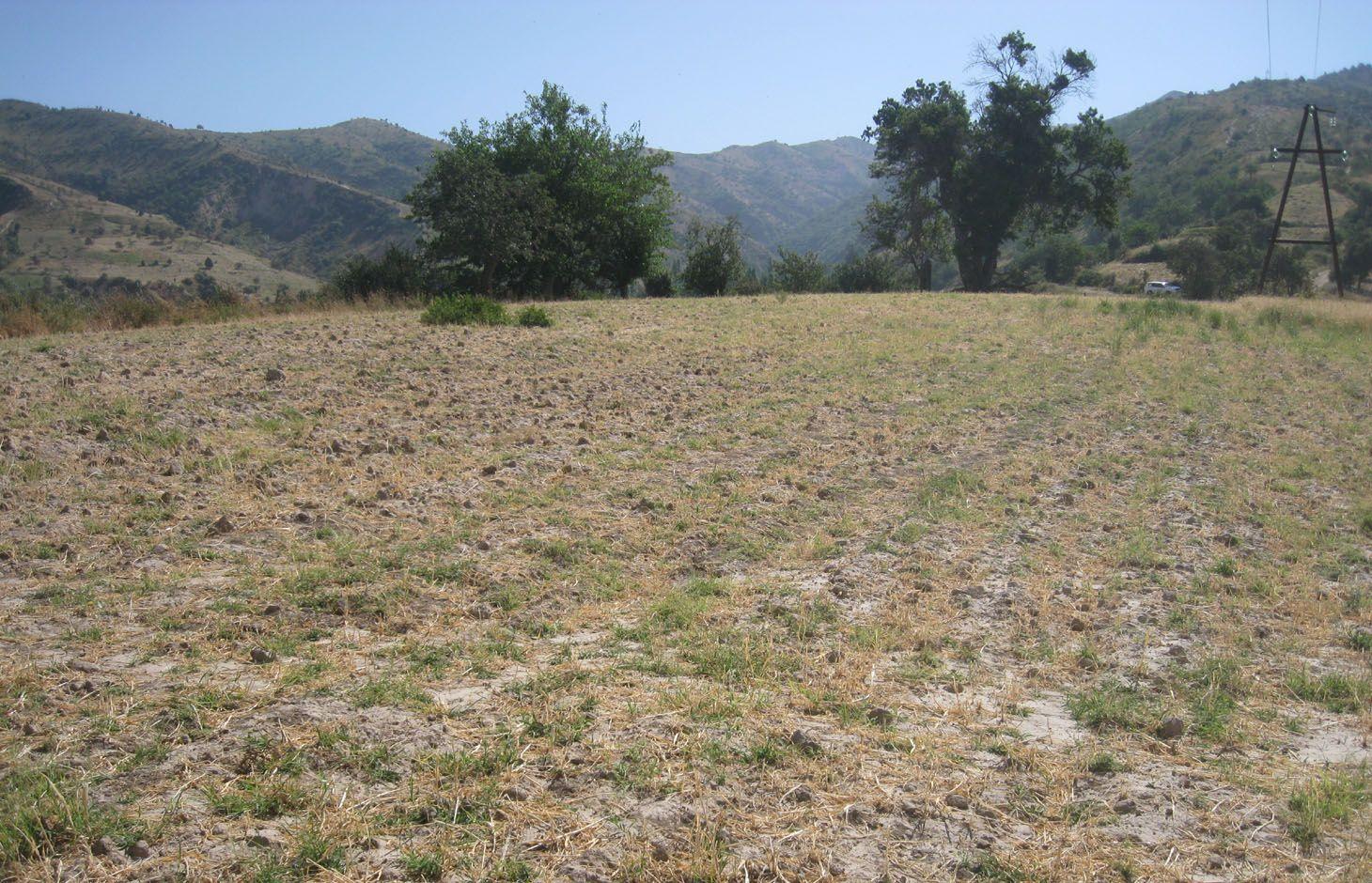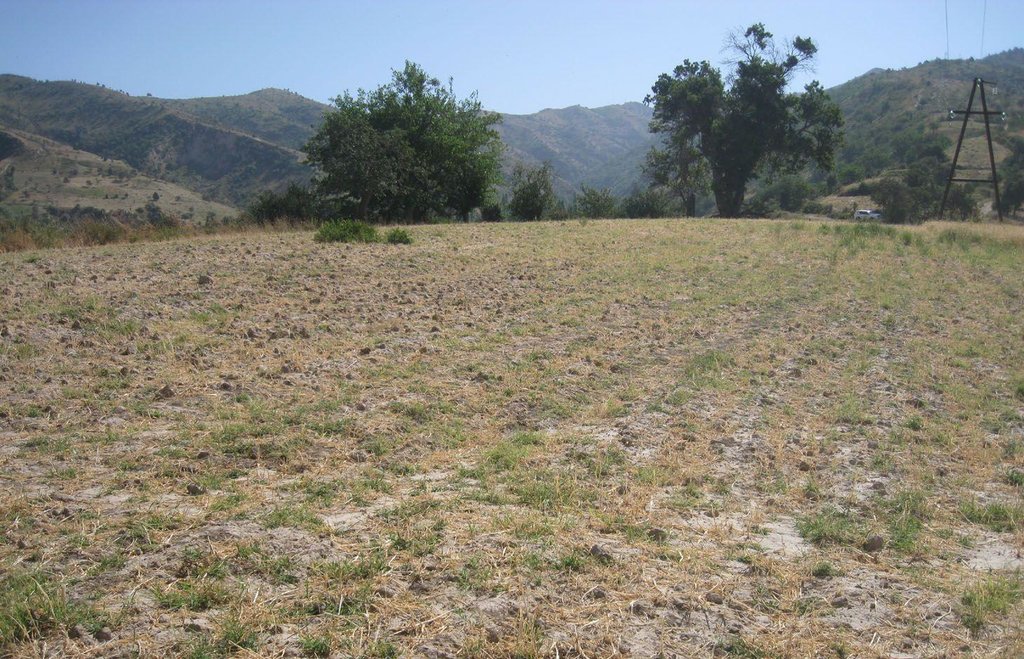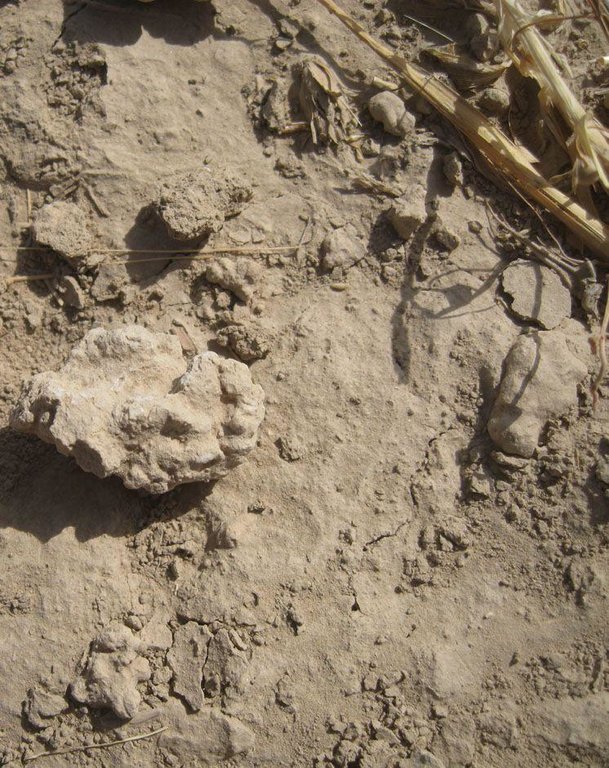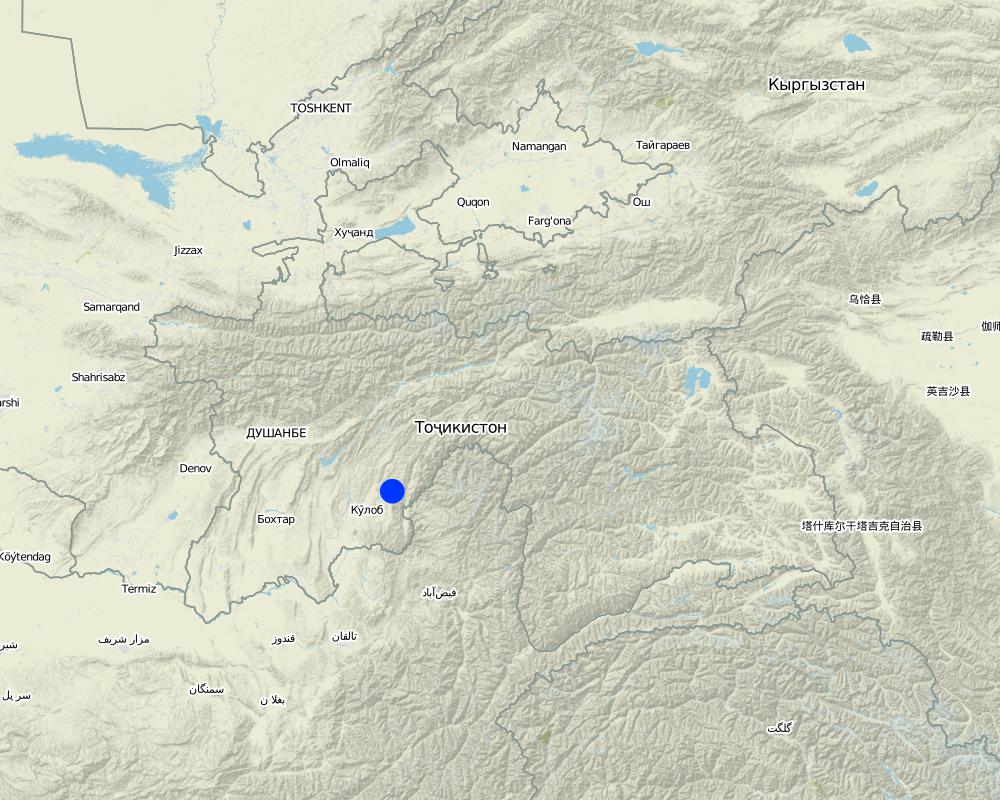Current feed grain cultivation [塔吉克斯坦]
- 创建:
- 更新:
- 编制者: Malgorzata Conder
- 编辑者: –
- 审查者: Fabian Ottiger, Alexandra Gavilano
technologies_1158 - 塔吉克斯坦
查看章节
全部展开 全部收起1. 一般信息
1.2 参与该技术评估和文件编制的资源人员和机构的联系方式
有助于对技术进行记录/评估的机构名称(如相关)
CDE Centre for Development and Environment (CDE Centre for Development and Environment) - 瑞士1.3 关于使用通过WOCAT记录的数据的条件
编制者和关键资源人员接受有关使用通过WOCAT记录数据的条件。:
是
2. SLM技术的说明
2.1 技术简介
技术定义:
Cultivation of wheat or feed grain for straw production on a degraded plot
2.2 技术的详细说明
说明:
The farmer started to plant flax for oil production on his 0.2 hectare plot, which gave a good harvest. Since 1999 the farmer has cultivated wheat and feed grain, rotating year by year. According to the farmer, wheat and feed grain cropping does not provide a benefit on that plot, when money and labour inputs are considered. But as straw is scarce but is needed for his cows, the farmer gets that by-product from harvesting wheat. Furthermore, as that plot is accessible by the tractor for ploughing, he plants wheat and will continue doing that in future, even though the output is low. Though the farmer has a land user's certificate for that property, it becomes common for livestock grazing after the harvest. This causes overgrazing, bare soil, trampling and other issues.
Purpose of the Technology: The purpose of cropping wheat is to get straw for feeding. According to the farmer the bad quality of soil and the absence of water do not allow a different crop type than wheat.
Establishment / maintenance activities and inputs: Establishment and maintenance activities are almost the same. The crop must be ploughed, seeds planted and fertilizer applied. Though no fertilizer was needed at the beginning of crop cultivation, now its use is increasing. Between the time of planting and harvesting, the crop is regularly safe guarded from grazing livestock. If herds approach, the farmer or a family member will protect the crop. After the harvest, the crop is somehow declared as communal land, where cattle are allowed to graze there.
Natural / human environment: The crop is situated on a ridge above the village of Chargii bolo. It is a small sized terrace with a slight slope. Soil quality and moisture were already very poor when the crop was established, which results in a low output comparing to the input. The soil is compacted and shows a low level of organic matter, soil moisture and nutrients. The farmer complains about the small sharp stones of around 1-2 cm of diameter in the soil. They indicate a high level of soil degradation. Although the slope is slight, the vertical ploughing has caused small rills in the lower part of the plot and some more pronounced rills off-site. The plot is the property of the farmer, but is used as pasture after harvest for the livestock. Soil compaction, lowered vegetation cover and water infiltration result from trampling and overgrazing. There’s no agreement between cultivars and herders, reason why this crop continues to be grazed uncontrolled.
2.3 技术照片
2.5 已应用该技术的、本评估所涵盖的国家/地区/地点
国家:
塔吉克斯坦
区域/州/省:
Khatlon, Tajikistan
有关地点的进一步说明:
Muminobod
具体说明该技术的分布:
- 均匀地分布在一个区域
如果不知道精确的区域,请注明大致覆盖的区域:
- < 0.1 平方千米(10 公顷)
Map
×2.6 实施日期
如果不知道确切的年份,请说明大概的日期:
- 10-50年前
2.7 技术介绍
详细说明该技术是如何引入的:
- 通过土地使用者的创新
注释(项目类型等):
Since 1999. Farmer claims that he only can cultivate wheat on that crop.
3. SLM技术的分类
3.1 该技术的主要目的
- 改良生产
- 创造有益的经济影响
3.2 应用该技术的当前土地利用类型

农田
- 一年一作
年作 - 具体指明作物:
- 饲料作物 - 草
- 饲料作物 - 其他
每年的生长季节数:
- 1
具体说明:
Longest growing period in days: 180 Longest growing period from month to month: April-Sept/Oct
注释:
Major land use problems (compiler’s opinion): Low soil nutrients and moisture on that plot. Bare and crusted soil which cause worse infiltration capacities and soil erosion. Building of small rills enhanced through vertical ploughing.
Additionally, overgrazing by livestock, compaction of soil.
Major land use problems (land users’ perception): Crop was already degraded at the beginning but its getting worse. Small and sharp stones which are in the soil indicate the compaction and low level of nutrients.
Livestock is grazing on crop residues
3.4 供水
该技术所应用土地的供水:
- 雨养
3.5 该技术所属的SLM组
- 轮作制度(轮作、休耕、轮垦)
- 畜牧业和牧场管理
- Feed grain cultivation
3.7 该技术强调的主要土地退化类型

土壤水蚀
- Wt:表土流失/地表侵蚀
- Wo:场外劣化效应

物理性土壤退化
- Pc:压实

生物性退化
- Bc:植被覆盖的减少
注释:
Main type of degradation addressed: Pc: compaction, Bc: reduction of vegetation cover
Secondary types of degradation addressed: Wt: loss of topsoil / surface erosion, Wo: offsite degradation effects
Main causes of degradation: soil management (vertical plowing), land tenure (cropping and afterwards grazing)
Secondary causes of degradation: overgrazing
3.8 防止、减少或恢复土地退化
具体数量名该技术与土地退化有关的目标:
- 修复/恢复严重退化的土地
4. 技术规范、实施活动、投入和成本
4.1 该技术的技术图纸
技术规范(与技术图纸相关):
Vertical tillage by tractor on the slightly inclined crop is about to build a small rill. The absence of vegetation and additional grazing causes soil crusting and formation of small sharp stones.
Location: Chargi bolo. Muminabad, Khatlon, Tajikistan
Agronomic measure: vertical tillage
Material/ species: one year feed grain, next year wheat
4.2 有关投入和成本计算的一般信息
其它/国家货币(具体说明):
Somoni
如相关,注明美元与当地货币的汇率(例如1美元=79.9巴西雷亚尔):1美元=:
4.83
注明雇用劳工的每日平均工资成本:
12.40
4.5 维护/经常性活动
| 活动 | 时间/频率 | |
|---|---|---|
| 1. | Plowing, 11 hours, 1 person | spring (7.April)/ once a year |
| 2. | Sowing wheat, 10-12 hours, 3 persons | spring (7.April)/once a year |
| 3. | Applying fertilizer, 10 hours, 1 person | spring (20.Mai)/ once a year |
| 4. | Cutting wheat, 4-5 days, 3 persons | autumn/ once a year |
| 5. | Guarding, 1 person | unregularly - sporadically |
4.6 维护/经常性活动所需要的费用和投入(每年)
| 对投入进行具体说明 | 单位 | 数量 | 单位成本 | 每项投入的总成本 | 土地使用者承担的成本% | |
|---|---|---|---|---|---|---|
| 劳动力 | Plowing | Person days | 1.4 | 12.214 | 17.1 | 100.0 |
| 劳动力 | Sowing wheat | Person days | 4.125 | 12.412 | 51.2 | 100.0 |
| 劳动力 | Applying fertilizer | Person days | 1.4 | 12.214 | 17.1 | 100.0 |
| 劳动力 | Cutting wheat | Person days | 13.5 | 12.422 | 167.7 | 100.0 |
| 设备 | Petrol | liters | 14.0 | 1.14 | 15.96 | 100.0 |
| 设备 | Machine use | hours | 2.0 | 2.6 | 5.2 | 100.0 |
| 植物材料 | Seeds | 12.4 | 100.0 | |||
| 肥料和杀菌剂 | Fertilizer | kg | 12.0 | 0.755 | 9.06 | 100.0 |
| 其它 | Guarding | |||||
| 技术维护所需总成本 | 283.32 | |||||
| 技术维护总成本,美元 | 58.66 | |||||
注释:
Labour, machine use and petrol was indicated for totally 0.8 ha, this is why all input is divided by 4 for the compilation of reccurent activities for the plot of 0.2 ha. The input were further multiplied by factor 5 for the cost overview for one ha.
4.7 影响成本的最重要因素
描述影响成本的最决定性因素:
Agricultural inputs as seeds and fertilizer are the most expensive
5. 自然和人文环境
5.1 气候
年降雨量
- < 250毫米
- 251-500毫米
- 501-750毫米
- 751-1,000毫米
- 1,001-1,500毫米
- 1,501-2,000毫米
- 2,001-3,000毫米
- 3,001-4,000毫米
- > 4,000毫米
有关降雨的规范/注释:
Totally 800 mm: 700mm in winter-spring, July-Sept dry season
农业气候带
- 半湿润
Thermal climate class: temperate
5.2 地形
平均坡度:
- 水平(0-2%)
- 缓降(3-5%)
- 平缓(6-10%)
- 滚坡(11-15%)
- 崎岖(16-30%)
- 陡峭(31-60%)
- 非常陡峭(>60%)
地形:
- 高原/平原
- 山脊
- 山坡
- 山地斜坡
- 麓坡
- 谷底
垂直分布带:
- 0-100 m a.s.l.
- 101-500 m a.s.l.
- 501-1,000 m a.s.l.
- 1,001-1,500 m a.s.l.
- 1,501-2,000 m a.s.l.
- 2,001-2,500 m a.s.l.
- 2,501-3,000 m a.s.l.
- 3,001-4,000 m a.s.l.
- > 4,000 m a.s.l.
关于地形的注释和进一步规范:
Slopes on average: Moderate (ranked 1) and rolling (ranked 2, up to 11%)
5.3 土壤
平均土层深度:
- 非常浅(0-20厘米)
- 浅(21-50厘米)
- 中等深度(51-80厘米)
- 深(81-120厘米)
- 非常深(> 120厘米)
土壤质地(表土):
- 中粒(壤土、粉土)
- 细粒/重质(粘土)
如有可能,附上完整的土壤描述或具体说明可用的信息,例如土壤类型、土壤酸碱度、阳离子交换能力、氮、盐度等。:
Soil fertility: High
Soil drainage/infiltration: Poor (presence of "compacted stones" of 1-2 cm in the soil)
Soil water storage capacity: Very low
5.4 水资源可用性和质量
地表水的可用性:
匮乏/没有
水质(未处理):
仅供农业使用(灌溉)
5.5 生物多样性
物种多样性:
- 低
5.6 应用该技术的土地使用者的特征
生产系统的市场定位:
- 生计(自给)
非农收入:
- 低于全部收入的10%
相对财富水平:
- 平均水平
机械化水平:
- 手工作业
- 机械化/电动
说明土地使用者的其他有关特征:
Population density: 100-200 persons/km2
Annual population growth: 1% - 2%
Level of mechanization: Mechanised (Ploughing and cutting fodder grain, ranked 1) and manual labour (sowing and putting fertilizer, ranked 2)
5.7 应用该技术的土地使用者使用的平均土地面积
- < 0.5 公顷
- 0.5-1 公顷
- 1-2 公顷
- 2-5公顷
- 5-15公顷
- 15-50公顷
- 50-100公顷
- 100-500公顷
- 500-1,000公顷
- 1,000-10,000公顷
- > 10,000公顷
5.8 土地所有权、土地使用权和水使用权
土地所有权:
- 个人,有命名
土地使用权:
- 租赁
用水权:
- 社区(有组织)
5.9 进入服务和基础设施的通道
健康:
- 贫瘠
- 适度的
- 好
教育:
- 贫瘠
- 适度的
- 好
技术援助:
- 贫瘠
- 适度的
- 好
就业(例如非农):
- 贫瘠
- 适度的
- 好
市场:
- 贫瘠
- 适度的
- 好
能源:
- 贫瘠
- 适度的
- 好
道路和交通:
- 贫瘠
- 适度的
- 好
饮用水和卫生设施:
- 贫瘠
- 适度的
- 好
金融服务:
- 贫瘠
- 适度的
- 好
6. 影响和结论性说明
6.1 该技术的现场影响
社会经济效应
生产
作物生产
收入和成本
农业投入费用
工作量
注释/具体说明:
less/ no guardening
社会文化影响
食品安全/自给自足
生态影响
水循环/径流
水量
地表径流
蒸发
土壤
土壤水分
土壤覆盖层
土壤结壳/密封
土壤压实
土壤有机物/地下C
6.2 该技术的场外影响已经显现
缓冲/过滤能力
对邻近农田的破坏
6.3 技术对渐变气候以及与气候相关的极端情况/灾害的暴露和敏感性(土地使用者认为的极端情况/灾害)
渐变气候
渐变气候
| 季节 | 增加或减少 | 该技术是如何应对的? | |
|---|---|---|---|
| 年温度 | 增加 | 不好 |
气候有关的极端情况(灾害)
气象灾害
| 该技术是如何应对的? | |
|---|---|
| 局地暴雨 | 不好 |
| 局地风暴 | 未知 |
气候灾害
| 该技术是如何应对的? | |
|---|---|
| 干旱 | 不好 |
水文灾害
| 该技术是如何应对的? | |
|---|---|
| 比较和缓的(河道)洪水 | 不好 |
其他气候相关的后果
其他气候相关的后果
| 该技术是如何应对的? | |
|---|---|
| 缩短生长期 | 未知 |
6.7 该技术的优点/长处/机会
| 土地使用者眼中的长处/优势/机会 |
|---|
| Suitable cropland for wheat production as it is accessible by tractor and shows a small inclination. |
6.8 技术的弱点/缺点/风险及其克服方法
| 编制者或其他关键资源人员认为的弱点/缺点/风险 | 如何克服它们? |
|---|---|
| Soil erosion, high run off rate, low infiltration capacity, low soil moisture. |
Countour tillage, crop rotation, double digging or breaking of compacted subsoil. Knowledge transfer for showing alternatives to wheat and fodder grain cropping (crop rotation). |
| Uncontrolled grazing after the harvest reduces vegetation cover to hardly no cover, which makes soil very exposed to soil erosion etc. | Regulate and coordinate grazing. |
7. 参考和链接
7.1 信息的方法/来源
链接和模块
全部展开 全部收起链接
无链接
模块
无模块





